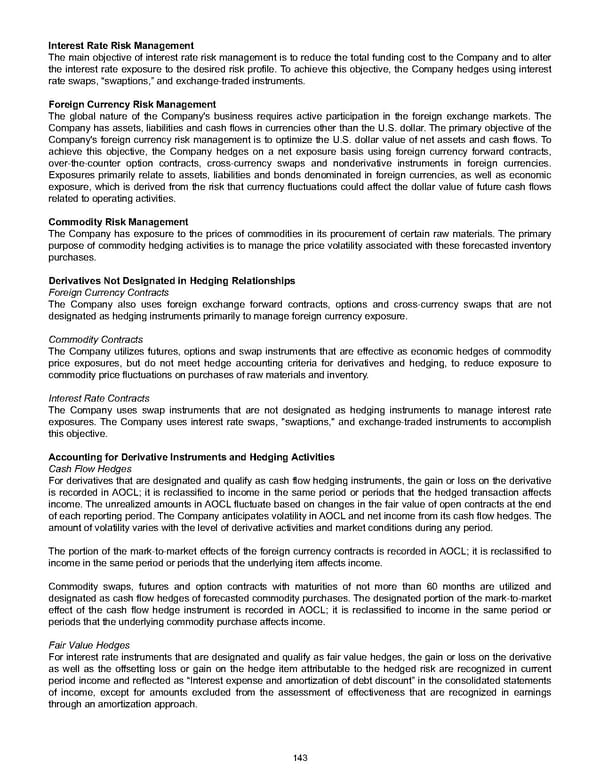Interest Rate Risk Management The main objective of interest rate risk management is to reduce the total funding cost to the Company and to alter the interest rate exposure to the desired risk profile. To achieve this objective, the Company hedges using interest rate swaps, “swaptions,” and exchange-traded instruments. Foreign Currency Risk Management The global nature of the Company's business requires active participation in the foreign exchange markets. The Company has assets, liabilities and cash flows in currencies other than the U.S. dollar. The primary objective of the Company's foreign currency risk management is to optimize the U.S. dollar value of net assets and cash flows. To achieve this objective, the Company hedges on a net exposure basis using foreign currency forward contracts, over-the-counter option contracts, cross-currency swaps and nonderivative instruments in foreign currencies. Exposures primarily relate to assets, liabilities and bonds denominated in foreign currencies, as well as economic exposure, which is derived from the risk that currency fluctuations could affect the dollar value of future cash flows related to operating activities. Commodity Risk Management The Company has exposure to the prices of commodities in its procurement of certain raw materials. The primary purpose of commodity hedging activities is to manage the price volatility associated with these forecasted inventory purchases. Derivatives Not Designated in Hedging Relationships Foreign Currency Contracts The Company also uses foreign exchange forward contracts, options and cross-currency swaps that are not designated as hedging instruments primarily to manage foreign currency exposure. Commodity Contracts The Company utilizes futures, options and swap instruments that are effective as economic hedges of commodity price exposures, but do not meet hedge accounting criteria for derivatives and hedging, to reduce exposure to commodity price fluctuations on purchases of raw materials and inventory. Interest Rate Contracts The Company uses swap instruments that are not designated as hedging instruments to manage interest rate exposures. The Company uses interest rate swaps, "swaptions," and exchange-traded instruments to accomplish this objective. Accounting for Derivative Instruments and Hedging Activities Cash Flow Hedges For derivatives that are designated and qualify as cash flow hedging instruments, the gain or loss on the derivative is recorded in AOCL; it is reclassified to income in the same period or periods that the hedged transaction affects income. The unrealized amounts in AOCL fluctuate based on changes in the fair value of open contracts at the end of each reporting period. The Company anticipates volatility in AOCL and net income from its cash flow hedges. The amount of volatility varies with the level of derivative activities and market conditions during any period. The portion of the mark-to-market effects of the foreign currency contracts is recorded in AOCL; it is reclassified to income in the same period or periods that the underlying item affects income. Commodity swaps, futures and option contracts with maturities of not more than 60 months are utilized and designated as cash flow hedges of forecasted commodity purchases. The designated portion of the mark-to-market effect of the cash flow hedge instrument is recorded in AOCL; it is reclassified to income in the same period or periods that the underlying commodity purchase affects income . Fair Value Hedges For interest rate instruments that are designated and qualify as fair value hedges, the gain or loss on the derivative as well as the offsetting loss or gain on the hedge item attributable to the hedged risk are recognized in current period income and reflected as “Interest expense and amortization of debt discount” in the consolidated statements of income, except for amounts excluded from the assessment of effectiveness that are recognized in earnings through an amortization approach. 143
 Annual Report Page 152 Page 154
Annual Report Page 152 Page 154